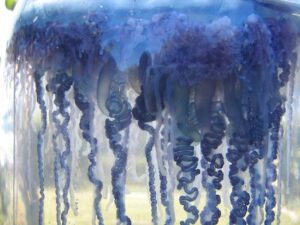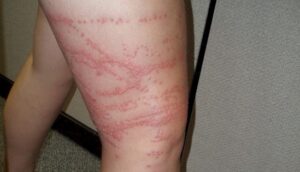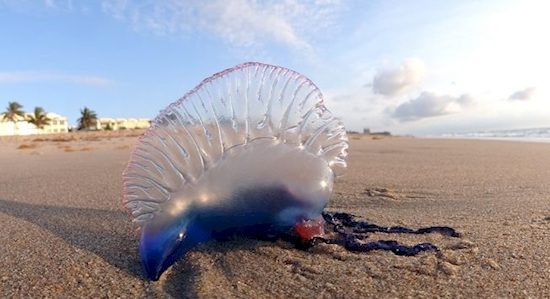According to Drishti Life Guard services, their lifeguards have spotted jellyfish washed ashore along the Baina-Velsao-Betalbatim beach stretch in South Goa, this season.
R A Sreepada, an NIO scientist has said that, A few factors, like nutrients from manure runoffs, ballast water discharge and contrasting temperatures, are responsible for the growth of jelly fish. He claims that a concentration in these nutrient levels is one of the main factors for their growth,”
One of the better-known species is that floating terror – the Bluebottle or Portuguese-man-of-war. Actually this creature is not really a Jellyfish. While Jellyfish are typically single multi-celled organism. The Man-o-war is a actually a whole colony of organisms. And its sting is more lethal than a jellyfish.
Though the Man-o-war is pretty to look at, its sting can be lethal, the Portuguese-man-of-war resembles a pretty blue bubble bobbing on the water. The poison lies in the tentacles that sway harmlessly beneath the surface. The detached tentacles also contain harmful venom. These may drift for days in the water, and the swimmer may not have any immediate idea if he or she has been stung by a ‘man-of-war’ or by some other less-venomous creature.
However, once the venom sets in, the stings from a Portuguese man o’ war are often extremely painful. You’ll get severe dermatitis characterized by long, thin open wounds that resemble wounds caused by a whip. These whip-like wounds are are not caused by any impact or cutting action, but by irritating urticariogenic substances in the tentacles.To treatment a Portuguese man o’ war sting, pour salt water to rinse away any remaining venom or stings. Remember to use salt water and not fresh water, because fresh water has been shown to discharge even more venom. Whatever you do, do not scrape off any stingers that may still be embedded in the skin. This could cause even more discharge of venom.

Cases of stings have been experienced in Goa over the years but have gone unreported. One such incident took place in March at Sernabatim. A beautiful, pristine beach in South Goa.
A local picnicker, Jason Fernandez was stung while swimming. Sharing his experience with Itsgoa.com he said, “it was a long and soft ribbon-like thing that wrapped around my thigh while swimming. It definitely was not seaweed and felt quite eerie.” His instant reaction, he said, was to get it off his thigh. Little did he know that the venom in the tentacle was enough to cause harm.

A few seconds later he felt a surge of pain on the back of his thigh and fingers. Not knowing what it was he said, “I decided to come out of the water. My fingers and palm too began to itch and hurt. Tiny red blisters were visible by now on the fingers that touched it as well as on the thigh. The thigh hurt badly.”
Sensing it was a sting of some sort, a family member advised him to put urine on it – ‘the local remedy for sea stings’. “I must admit that did help initially but the pain only increased later on.”It wasn’t very severe so he did not feel the need to visit a doctor. But later applied some antiseptic skin cream that gave a lot of relief. “It took few days for the pain to subside and the wounds to heal,” he said.
The sting was not so severe as it may have been a broken tentacle of the ‘man-o-war’ that was floating around. A powerful sting can be fatal.
March, April, and May are the months when these Floating Terrors come ashore. But this year they seems to cave come ashore even now. Thankfully, the lifeguards on Goan beaches are equipped with first aid kits to deal with such incidents. (We spoke to a lifeguard at the beach and he said there were a lot of cases of ‘jellyfish stings’.) But it is best to visit the nearest medical practitioner for advice. Remember this creature is not a jellyfish but a lethal ‘Portuguese-man-of-war.’
The sting may or may not be severe. So don’t panic! If help is not available then follow the steps below:
- Use salt water to gently wash the area and remove any “unfired” nematocysts (the sting) away from the wound. Care must be taken not to allow the pieces to touch other parts of the skin as the venom is still active.
- Then douse the sting area with vinegar. It is known to diffuse any poison that may be more active in the nematocysts present in the tentacles.
- If need be apply shaving cream and shave the area gently to remove the bits
- Visit your nearest doctor if the sting is severe.
- Apply a hot pad (as hot as you can tolerate) to the area as heat further breaks down the toxins.
- Then apply Hydrocortisone cream till the wound heals.
- Contrary to local beliefs, urine may react with the poison in the sting and cause more irritation to the wound…so use it at your own risk!
(Note: Vinegar does not help if the sting is from smaller species)
Here’s wishing you a fun time at the beach and hopefully you won’t meet any of these “medusas” of the sea. If you do, don’t panic. Remember the tips we gave you, and get in tough with the Drishti lifeguards immediately. If needed, they will take you to a local doctor.


